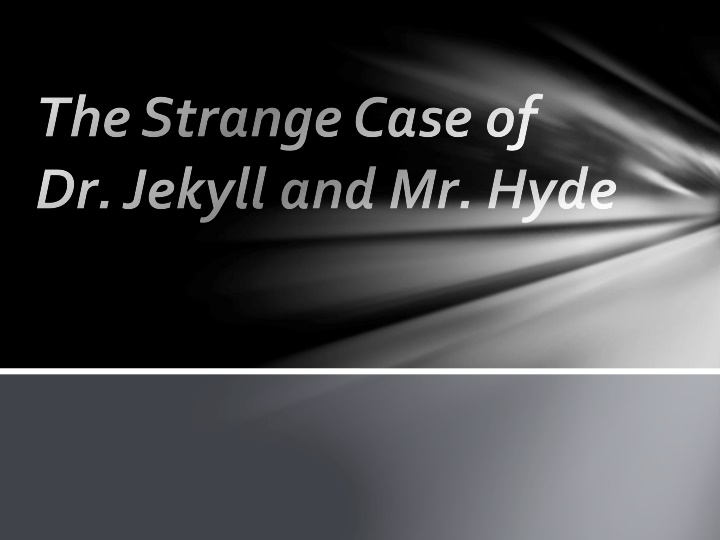Insights into "The Strange Case of Dr. Jekyll and Mr. Hyde" by Robert Louis Stevenson
Explore the intriguing background and themes behind Robert Louis Stevenson's famous novella, including the duality of human nature, Victorian England's societal norms, and the influence of contemporary ideas such as Charles Darwin's theory of evolution and Sigmund Freud's psychoanalytic concepts. Discover the connections between Stevenson's work and the prevalent drug use of the time, shedding light on the era's cultural influences on this timeless literary tale.
Download Presentation

Please find below an Image/Link to download the presentation.
The content on the website is provided AS IS for your information and personal use only. It may not be sold, licensed, or shared on other websites without obtaining consent from the author.If you encounter any issues during the download, it is possible that the publisher has removed the file from their server.
You are allowed to download the files provided on this website for personal or commercial use, subject to the condition that they are used lawfully. All files are the property of their respective owners.
The content on the website is provided AS IS for your information and personal use only. It may not be sold, licensed, or shared on other websites without obtaining consent from the author.
E N D
Presentation Transcript
The Strange Case of Dr. Jekyll and Mr. Hyde
RLS Fun Facts His first great writing success was Treasure Island, a thrilling story of a swashbuckling pirate named Long John Silver. RLS has a good claim as the inventor of the sleeping bag, taking a large fleece-lined sack with him to sleep on his journey through France. RLS was very interested by the idea that a man could possess two contradictory personalities one good and one evil. This idea is said to be modeled by the late 18thcentury case of Deacon Brodie, a respectable Edinburgh businessman by day and a gambler/adulterer/armed robber/ murderer by night. RLS wrote Dr. Jekyll and Mr. Hyde in three days after awaking one night from a nightmare.
In each of us, two natures are at war - the good and the evil. All our lives the fight goes on between them, and one of them must conquer. But in our hands lies the power to choose - what we want most to be, we are." -Robert Louis Stevenson
Victorian England Victorian morality supported sexual restraint, low tolerance of crime, and a strict social code of conduct. Victorian prudery sometimes went so far as to deem it improper to say leg in mixed company. Historians now regard the Victorian era as a time of contradictions the outward appearance of dignity and restraint together with the prevalence of prostitution and child labor.
A Sign of the Times Charles Darwin s theory of evolution came out in 1857. (The Strange Case of Dr. Jekyll & Mr. Hyde saw instant success in 1886.) Interestingly, Hyde is described as apelike and as moving like a monkey in the novel. He is also described as troglodytic, or like a cave man, comparing him to the first man or natural man. Sigmund Freud, the father of psychotherapy, lived at the same time Jekyll and Hyde was published. Freud named the conscious part of oneself the ego. He named the unconscious part of oneself the id. He also labeled the superego as society, ethics, and morals. Stevenson was on the cutting edge of science to be writing about division in the human mind.
A Sign of the Times (continued) Drug use and abuse was increasing during Stevenson s time. A popular drug of the time was opium (a highly addictive drug). It was frequently prescribed, even to children to help them sleep. Connection: Edgar Allan Poe had a problem with opium. He even referenced an opium-eater s dream in his poem The Raven. Stevenson was said to be using cocaine when he wrote The Strange Case of Dr. Jekyll and Mr. Hyde.
Duality of London Cavendish Square, the area in which Jekyll, Utterson, and Lanyon live, was the wealthiest part of London. Only a few blocks away, one would find ghettos, such as Soho, where Hyde kept his residence. Soho was a part of London known for its immigrant population. People tended to keep to the main thoroughfares because a wrong turn could land you in the ghetto and exposed to theft or worse. Also, due to the emphasis on society and social class, people tended to stay in their own neighborhood Many Londoners led double lives though, attending church and working in the wealthy part of London and participating in other behaviors in ghettos like Soho.
First Interpretation: Born Evil RLS had a strict Christian and moral upbringing. The idea of good vs. evil was one the was quite familiar. Adam & Eve vs. Serpent Cain vs. Abel Thomas Hobbes thought that humans were naturally bad and would be animals in a state of nature In Christianity, original sin says that people are born inclined toward evil and struggle to be good.
Second Interpretation: Society Makes us Evil Context: Takes place in Victorian Era (1837-1901) in London, England Members of the upper class in Victorian times were especially expected to behave virtuously. They, along with their homes, were expected to be proper and elegant at all times. Victorian society was divided. Social classes did not mix, and behavior, especially among members of the upper class, was to be exemplary at all times. The unrealistically rigid morality of upper class Londoners led many to live double lives.
Second Interpretation: Society Makes us Evil The Enlightenment view was the people are born blank slates. Society shapes the person into good or evil Sigmund Freud, the father of psychotherapy, believed that human beings are powerfully influenced by impulses they are not aware of. Personality: Freud said there were three parts to a person s psychology Ego the conscious part of oneself (adult) Id the unconscious part of oneself (childlike) Superego society, ethics , and morals To many readers, Hyde represents Dr. Jekyll s subconscious desire to be freed from society s restrictions. People need to repress desires for society to work.


















![Negligence Liability in Donoghue v. Stevenson [1932]](/thumb/198881/negligence-liability-in-donoghue-v-stevenson-1932.jpg)




